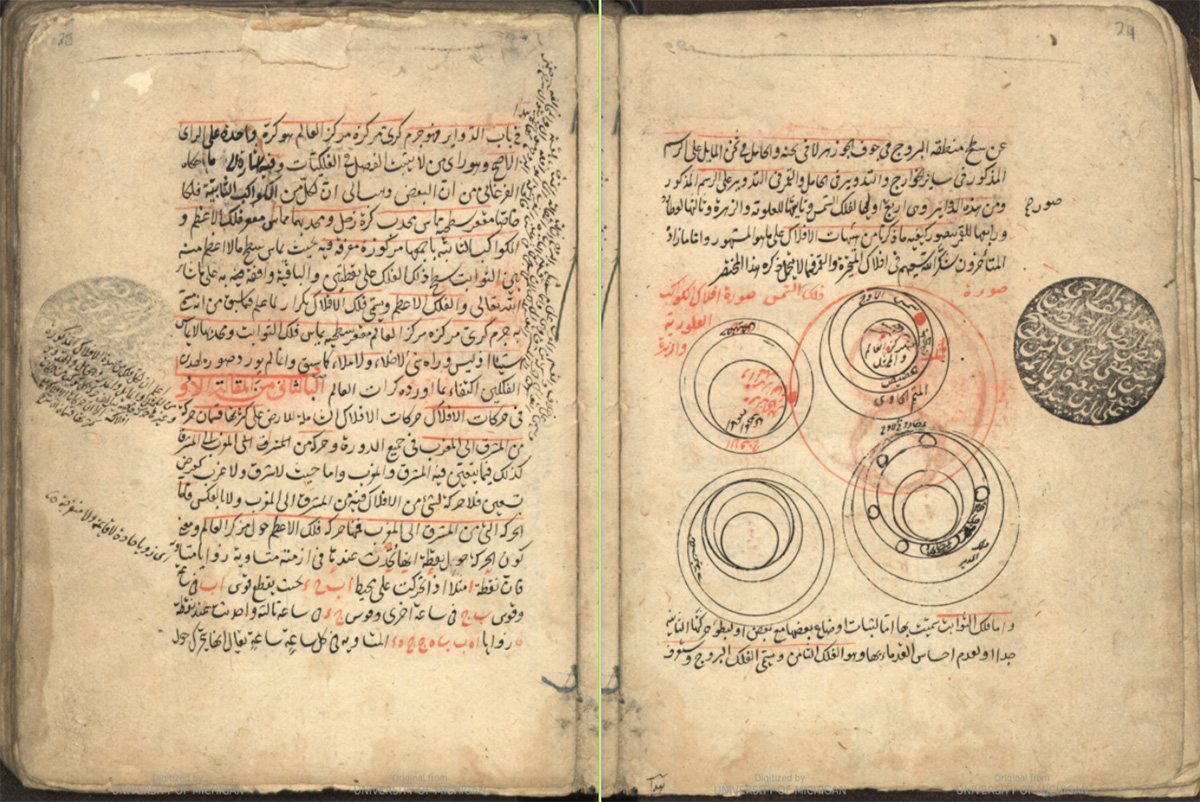Work of the Observatory: Qāḍīʼzādah al-Rūmī (d.1436?)
15th century Samarqand

- شرح الجغميني الخ
- موسى بن محمد قاضي زاده الرومي
- [Sharḥ al-Jighmīnī... etc].
- Mūsá ibn Muḥammad Qāḍīʼzādah al-Rūmī (d.1436?)
- ca. 1473 or 1474.
- Arabic.
- Manuscript codex on laid paper with grouped chain lines.
- Isl. Ms. 120, p.24/25.
This single volume includes multiple works by the astronomer Mūsá ibn Muḥammad Qāḍīʼzādah al-Rūmī (d.1436?), noted for his role in the work of the Samarqand observatory established in 1420 under Ulugh Beg and for writings which became widely used teaching texts in astronomy and mathematics.
Qāḍīʼzādah studied the philosophical and mathematical sciences in Samarqand and eventually became head of a large madrasah (traditional Islamic educational institution) there. With Ulugh Beg’s direction and patronage, he collaborated with the Persian mathematician and astronomer Ghiyāth al-Dīn al-Kāshī (d.1429) to construct the famous observatory and begin observations there. After al-Kāshī’s death, Qāḍīʼzādah assumed additional responsibilities and was assisted by ʻAlāʼ al-Dīn ʻAlī Qushjī who would eventually succeed him.
Appearing first in the present manuscript is Qāḍīʼzādah’s commentary on Maḥmūd ibn Muḥammad al-Jaghmīnī’s (d.1221 or 2) al-Mulakhkhaṣ fī al-hayʼah — a concise introduction to the physical configuration of the universe (hayʼah) including the celestial realm and terrestrial region. Enormously popular for centuries, al-Jaghmīnī’s Mulakhkhaṣ inspired dozens of commentaries and translations, with Qāḍīʼzādah’s commentary among the most influential. Many supercommentaries were written on it and it served as an intermediate textbook in Ottoman educational institutions.
Next in the volume is Qāḍīʼzādah’s commentary on Ashkāl al-taʼsīs, a selection of theorems from Euclid’s Elements prepared by Shams al-Dīn Muḥammad ibn Ashraf al-Samarqandī (13th cent.). Also included are assorted astronomical tables, another brief treatise, and the text of al-Samarqandī’s Ashkāl al-taʼsīs.
The late 15th century manuscript brings together the various texts in a single volume or anthology (majmūʻah), suitable for comparative study. Numerous explanatory diagrams elucidate the details in the text. The volume has been carefully consulted with readers leaving annotations, worksheets, and signs of wear. A large circular seal impression indicates that the volume was incorporated into a religious endowment for a scholarly library established in the 19th century and at least some of these readers (19th century contemporaries as evidenced by their handwriting) probably accessed the volume through the endowed library.
Select Bibliography
- Isl. Ms. 120 online catalogue record (E. Kropf).
- Ragep, F. Jamil. “Ḳāḍī-Zāde Rūmī.” In Encyclopaedia of Islam, Second Edition, edited by Peri Bearman et al.
- Ragep, Sally P. 2016. Jaghmīnī’s Mulakhkhaṣ. An Islamic Introduction to Ptolemaic Astronomy. New York: Springer.
- Ragep, Sally P. “al-Jaghmīnī.” In Encyclopaedia of Islam THREE, edited by Kate Fleet et al.